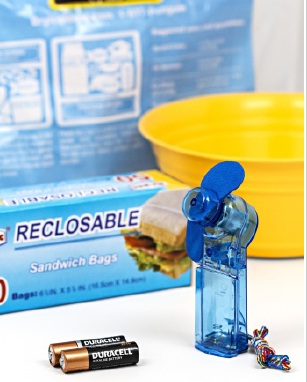





Published on Feb 13, 2025
The objective: Students will learn how the chemical energy in batteries is converted into electrical energy and test how this process is affected by extremes of temperatures.
How do alkaline batteries convert chemical energy to electrical energy?
How are the reaction rates of the chemical reactions in batteries affected by temperature?
How can we observe the change in reaction rates in alkaline batteries?

Alkaline batteries contain a cathode made from manganese dioxide and carbon, and an anode composed of z inc metal. An electrolyte solution - potassium hydroxide - fills the center where the chemical reaction giving rise to the electrical energy takes place. The electrolyte oxidiz es the metallic z inc, which in turn reacts with the cathode’s manganese dioxide to produce electricity. Like most chemical reactions, these reactions slow down in cold temperatures.
Small battery-powered fan powered by two AA alkaline batteries in a detachable battery pack. Other small battery-powered devices may be used as long as thebatteries are housed separately from the device.
Two AA alkaline batteries (any brand)*
Ice bucket
Dry ice
Regular ice
Zip-lock plastic bags
Jumper cable with alligator clips
Wall clock to use as a timer
A 9-volt alkaline battery that has electrodes coupled to the top of the battery can also be used. If a 9-volt battery is used, the jumper cable, alligator clips, and battery pack are not necessary.
1. Place the two AA batteries in the battery holder. Couple the battery holder to wires with alligator clips. Nest one plastic baggie inside another to insure that the bags are leak-proof. Put the battery pack into the interior plastic baggie with the wires coming out the top of the bag. Close the bag with elastic bands.
2. Couple the other end of the wires to the fan (or other battery powered device).
3. Turn the fan on and set a timer.
4 . Check to see that the fan is still on at least every 10-15 minutes.
5. Note the time when the batteries run out and the fan stops.
1. Repeat step #1 as outlined above.
2. Fill the ice bucket with ice. Put the plastic bag containing the battery pack into the ice.
3. Repeat step #2 as outlined above.
4 . Affter waiting 15 minutes for the temperatures of the batteries to equilibrate with the ice performs steps #3 - #5.
1. Repeat step #1 as outlined in Experiment #1 above
2. Wearing gloves, fill the ice bucket with ice. If necessary, break the dry ice into pieces with a hammer. Put the plastic bag containing the battery pack into the dry ice.
3. Repeat step #2 as outlined above in Experiment #1.
4 . After waiting 15 minutes for the temperatures of the batteries to equilibrate with the dry ice, perform steps #3 - #5 in Experiment #1.
Energiz er.com: Batteries 101 – How Batteries Work
http://www.energiz er.com/learning-center/Pages/how-batteries-work.aspx
How Stuff Works: How Batteries Work
http://www.howstuffworks.com/battery.htm
About.chemistry.com: Factors that Affect the Chemical Reaction Rate Reaction Kinetics
http://chemistry.about.com/od/stoichiometry/a/reactionrate.htm
Schlesinger, Henry. The Battery: How Portable Power Sparked a Technological Revolution. Smithsonian (2010)